Fri, 20 September 2024 03:06:41am
Is Your Online Account Hacked ? Here is How to Find Out and Protect Yourself

Is Your Online Account Hacked ? Here is How to Find Out and Protect Yourself
Have you ever had that sinking feeling that someone might be snooping around in your online accounts? With the increasing number of cyberattacks targeting regular users, it's crucial to know the signs of a hacked account and how to safeguard your digital life. Read on to discover essential steps to determine if your accounts have been compromised and what actions you can take to secure them.
Signs Your Account Might Be Hacked
- Unfamiliar Activity: If you notice any unusual activity, such as emails you didn't send or social media posts you didn't make, it's a red flag.
- Login Alerts: Receiving alerts about logins from unfamiliar locations or devices is a major warning sign.
- Password Changes: If your password suddenly stops working and you didn't change it, your account might be compromised.
Checking Your Accounts
Google/Gmail:
- Last Account Activity: Scroll to the bottom of your Gmail inbox and click on "Last account activity" to see where your account is logged in.
- Security Checkup: Click on "Security Checkup" to review the devices that have accessed your Google account.
- Recent Security Activity: Review any recent activity and click on "See unfamiliar activity?" if something looks suspicious. Change your password immediately.
For more details, follow Google's instructions on securing your account.
Microsoft Outlook:
- Sign-In Activity: Go to your Microsoft Account, click on "Security," and then "View my activity" to see recent logins.
- Make Your Account More Secure: If you notice anything unusual, change your password and follow Microsoft's guidelines on securing your account.
Visit Microsoft's support page for more information.
Enhanced Security Measures
- Enable Multi-Factor Authentication (MFA): This adds an extra layer of security by requiring a second form of verification, such as a text message or an authentication app. Use resources like this directory to enable MFA on various websites.
- Use Physical Security Keys: For maximum security, consider using physical security keys that plug into your device and verify your identity.
Professional Help
If you’re a high-risk individual, such as a journalist, activist, or someone with significant online presence, you should consider contacting professionals for assistance. Non-profits like Access Now offer digital security helplines that connect you to experts.
Conclusion
In today's digital age, knowing how to detect and respond to account breaches is essential. Regularly monitor your accounts for suspicious activity, enable enhanced security measures, and seek professional help if needed. By staying vigilant, you can protect your online identity and keep your personal information safe.
With these steps, you can better understand how to safeguard your accounts and what to do if you suspect a breach. Stay informed, stay secure, and don't let hackers disrupt your digital life.



